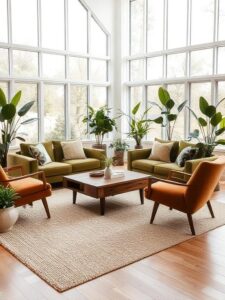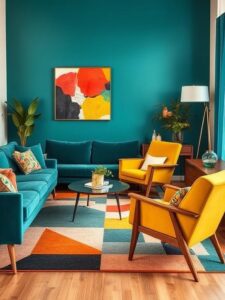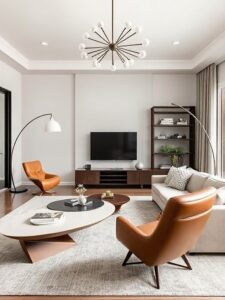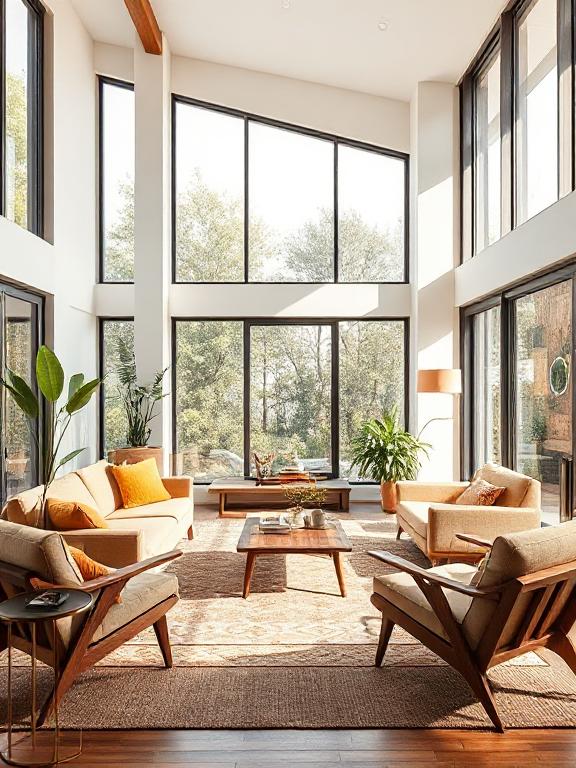When I think about timeless interior styles that continue to inspire homeowners and designers alike, Mid-Century Modern design is always at the top of the list. This aesthetic, which emerged in the mid-20th century, has proven that great design truly never goes out of style. Its clean lines, natural materials, and functional elegance offer a look that feels just as fresh today as it did decades ago.
For anyone searching for ways to create a living room that feels both stylish and inviting, Mid-Century Modern is a natural choice. The challenge, however, is making your living room stand out in a world where so many people are drawn to the same design principles. That’s exactly why I want to share three unique Mid-Century Modern living room design ideas that go beyond the basics, giving you fresh ways to interpret this iconic style.
By the end of this article, you’ll not only understand what makes Mid-Century Modern design so enduring but also discover creative approaches to personalize your space while staying true to its authentic character.
What Defines Mid-Century Modern Living Room Design?
Before diving into specific ideas, it’s important to truly understand the DNA of Mid-Century Modern living rooms. This style has key elements that make it instantly recognizable. If you’ve ever admired the effortless sophistication of furniture with tapered legs or the simplicity of geometric shapes, you’ve already encountered its essence.
At its core, Mid-Century Modern design embraces functionality. Every piece of furniture or décor is thoughtfully designed to serve a purpose without unnecessary embellishment. Clean lines, uncluttered spaces, and organic shapes form the foundation. Wood, particularly walnut and teak, is frequently used to add warmth and natural character, while leather, wool, and other textured fabrics provide comfort and depth.
Another defining feature is the clever use of color. While neutral tones dominate the palette—think soft grays, warm whites, and earthy browns—pops of vibrant hues such as mustard yellow, teal, and burnt orange often appear in accents like cushions, rugs, or artwork. These bold touches bring energy and personality without overwhelming the space.
Lighting also plays a pivotal role. Iconic floor lamps with sleek silhouettes, pendant lights, and sculptural chandeliers often become statement pieces in Mid-Century Modern living rooms. They’re not only functional but also act as works of art that enhance the entire design.
Why Choose a Mid-Century Modern Living Room?
One of the main reasons I recommend this style to clients is its ability to strike the perfect balance between aesthetics and comfort. Mid-Century Modern living rooms feel sophisticated but never overly formal, making them ideal for everyday living. They are spaces where you can entertain guests in style yet still curl up comfortably on a Sunday afternoon with a good book.
This design is also incredibly versatile. Whether your home leans toward a more minimalistic look or you love mixing patterns and textures, Mid-Century Modern elements can be adapted to suit your taste. For example, a classic wooden credenza works beautifully in a pared-down, neutral living room but can also serve as an anchor piece in a bolder, more eclectic space.
Another advantage is longevity. Investing in Mid-Century Modern furniture and décor often means investing in quality. Many of the iconic pieces designed in this era were built to last, both in craftsmanship and in style. Choosing this design approach is not just about keeping up with trends—it’s about creating a living room that will remain beautiful and relevant for years to come.
Lastly, I’ve found that this style resonates with those who want a touch of nostalgia without sacrificing modern convenience. There’s a certain charm in bringing pieces inspired by the 1950s and 60s into a contemporary setting. It allows you to celebrate history while still enjoying the benefits of modern living.
3 Unique Mid-Century Modern Living Room Design Ideas
When clients ask me how to make their Mid-Century Modern living room feel truly unique, I always encourage them to look beyond the obvious furniture choices. Yes, a sleek sofa or an Eames-inspired chair sets the tone, but the real magic happens when you layer in unexpected details. To help spark your imagination, here are three unique design ideas that will elevate your living room into something memorable and personal.
Idea One: Mid-Century Modern Meets Nature

One of the most refreshing ways to approach Mid-Century Modern design is to emphasize its connection to nature. After all, many original designs from this era were created to blur the lines between indoors and outdoors. I often suggest starting with large windows or glass doors that allow natural light to flood the room, instantly creating a sense of openness and warmth.
In terms of furniture, consider incorporating pieces crafted from raw wood with visible grains to highlight their organic beauty. Pair these with earthy-toned fabrics, such as moss green or rust, to mirror the natural world. A shag rug in a muted shade can also bring texture underfoot while keeping the palette cohesive.
Plants are the perfect finishing touch. From tall fiddle-leaf figs to smaller succulents in ceramic planters, greenery introduces freshness and balance. You can even choose planters with mid-century patterns or pedestal bases to tie everything together. The result is a living room that feels grounded, calm, and deeply connected to nature while staying true to Mid-Century Modern aesthetics.
Idea Two: Bold Mid-Century Color Play

While many people think of Mid-Century Modern living rooms as muted and understated, one of the most exciting aspects of this style is its playful use of color. To create a truly unique look, I often recommend leaning into bold, unexpected color pairings that still feel authentic to the era.
For instance, a deep teal sofa paired with mustard yellow accent chairs instantly creates a dynamic focal point while staying rooted in Mid-Century tradition. If you prefer something softer, try a base of earthy neutrals—such as taupe or cream—and then introduce accents of burnt orange, avocado green, or even a pop of pink through pillows, throws, or wall art.
One of my favorite techniques is to use color-blocking. A large geometric rug in contrasting shades can anchor the space, while statement art pieces bring the entire palette together. The key is to keep the bold colors balanced with natural materials, so the room doesn’t feel overwhelming. Think wood tones, stone accents, or woven textiles that soften and ground the palette.
This approach works particularly well for those who love expressing their personality through design. By embracing bold Mid-Century color play, you transform your living room into a vibrant, uplifting space that sparks conversation and creativity.
Idea Three: Sculptural Statement Pieces

If you want to take your Mid-Century Modern living room beyond the ordinary, incorporating sculptural statement pieces is a powerful way to do it. This design era celebrated innovation and artistry, and many of its most iconic pieces doubled as functional art.
Consider a coffee table with an asymmetrical base, a lounge chair with curved lines, or even a chandelier with an atomic-inspired design. These pieces instantly draw the eye and add a sense of sophistication that makes your living room memorable. I always remind my clients that one strong statement piece is often more effective than filling a room with too many competing designs.
You can also play with materials to heighten the sculptural effect. For example, a marble-topped side table with a sleek wooden base introduces contrast while keeping the design grounded. Similarly, a large arc floor lamp not only provides excellent lighting but also acts as a striking architectural feature in the space.
To make these statement pieces shine, keep the surrounding décor simple and supportive. A neutral sofa, clean-lined media console, and minimalist shelving will allow your sculptural elements to become the star of the room without overwhelming the overall aesthetic.
Styling Tips to Enhance Your Mid-Century Modern Living Room
Once you’ve chosen a direction for your design, the next step is layering in thoughtful styling details. In my experience, it’s these smaller touches that elevate a living room from good to unforgettable.
Here are a few tried-and-true tips I often share with clients:
-
Mix textures for depth – Combine smooth leather, cozy wool, and soft linen to create balance and warmth.
-
Add vintage accents – Authentic Mid-Century Modern pieces, like a vintage clock or ceramic vase, bring character and history to the space.
-
Incorporate open shelving – Display curated collections of books, art, or decorative objects without cluttering the room.
-
Balance symmetry and asymmetry – While clean lines are important, don’t be afraid to play with off-center arrangements to keep the room visually engaging.
-
Use layered lighting – Combine floor lamps, table lamps, and overhead fixtures for both function and mood.
These simple styling techniques not only reinforce the Mid-Century Modern aesthetic but also give your living room a polished, lived-in feel.
Common Mistakes to Avoid in Mid-Century Modern Design
While Mid-Century Modern design is relatively straightforward, I’ve seen many homeowners make mistakes that dilute the effect of the style. Avoiding these pitfalls will help you achieve a cohesive and authentic look.
One common mistake is overcrowding the room with too many pieces. This style thrives on simplicity, so it’s best to focus on quality rather than quantity. Another misstep is choosing furniture that only imitates the look without paying attention to proportion or craftsmanship. True Mid-Century pieces, or high-quality replicas, always feature careful attention to detail.
Another mistake is neglecting balance. For example, if you lean too heavily into bold colors or oversized furniture, the room can lose its sense of harmony. I always recommend stepping back and evaluating whether each piece contributes to the overall vision before finalizing the design.
Finally, avoid making the space feel like a showroom frozen in the past. The goal is to create a living room inspired by Mid-Century Modern principles, not a museum. Blending modern conveniences and personal touches ensures the space feels stylish yet comfortable.
Final Thoughts
Designing a Mid-Century Modern living room is about more than just choosing the right furniture—it’s about creating a space that reflects your lifestyle and personality. Whether you draw inspiration from nature, experiment with bold colors, or introduce sculptural statement pieces, the key is to embrace creativity while staying true to the principles of simplicity, functionality, and timeless design.
As someone who has worked with countless living spaces, I can confidently say that Mid-Century Modern is one of the most rewarding styles to work with. It offers endless flexibility, yet its core elements ensure that the result is always elegant and welcoming. By thoughtfully applying these three unique design ideas, you’ll be well on your way to crafting a living room that feels both current and enduring.
Frequently Asked Questions
What colors work best in a Mid-Century Modern living room?
Neutrals like gray, cream, and wood tones form the foundation, while accents of mustard yellow, teal, burnt orange, or even pink bring the look to life.
Can I mix Mid-Century Modern with other design styles?
Absolutely. This style pairs beautifully with contemporary, Scandinavian, and even bohemian influences when done thoughtfully.
What’s the most important furniture piece in this design style?
The sofa often sets the tone. Choosing a clean-lined sofa with tapered legs and quality upholstery gives your living room a strong foundation.
Do I need original vintage furniture to achieve this look?
Not at all. While authentic vintage pieces are wonderful, high-quality modern reproductions can achieve the same effect with more accessibility and affordability.
How do I keep my Mid-Century Modern living room from feeling outdated?
Balance is key. Use timeless furniture shapes but mix in modern lighting, updated textiles, or contemporary art to keep the look fresh and relevant.

